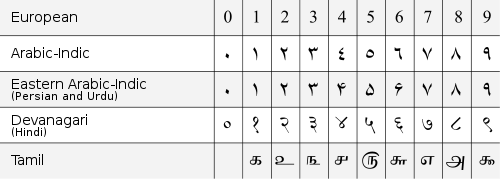- Modern Arabic mathematical notation
-
The designation modern Arabic mathematical notation is used for a mathematical notation based on the Arabic script that is widely used in the Arab world, especially at pre-university levels of education. Its form is mostly derived from Western notation, but has some notable features that set it apart from its Western counterpart. The most remarkable of those features is the fact that it is written from right to left following the normal direction of the Arabic script. Other differences include the replacement of the Latin alphabet letters for symbols with Arabic letters and the use of Arabic names for functions and relations.
Contents
- 1 Some features of Arabic mathematical notation
- 2 Arabic mathematical notation in different regions
- 3 Examples of Arabic mathematical notation
- 4 See also
- 5 External links
Some features of Arabic mathematical notation
- The most remarkable of those features is the fact that it is written from right to left following the normal direction of the Arabic script. Other differences include the replacement of the Latin alphabet letters for symbols with Arabic letters and the use of Arabic names for functions and relations.
- The notation exhibits one of the very few remaining vestiges of non-dotted Arabic scripts, as dots over and under letters (I'jam) are usually omitted.
- Letter cursivity (connectedness) of Arabic is also taken advantage of, in a few cases, to define variables using more than one letter. The most widespread example of this kind of usage is the canonical symbol for the radius of a circle نق (Arabic pronunciation: [nɑq]), which is written using the two letters nūn and qāf. When variable names are juxtaposed (as when expressing multiplication) they are written non-cursively.
Arabic mathematical notation in different regions
The notation differs slightly from region to another. In university-level education most regions use the Western notation. The notation mainly differs in numeral system used, and in mathematical symbol used
Numeral systems used in Arabic mathematical notation
There are three numeral systems used in right to left mathematical notation.
- "Western Arabic numerals" (sometimes called European) are used in western Arabic regions (e.g. Morocco)
- "Eastern Arabic numerals" are used in middle and eastern Arabic regions (e.g. Egypt and Syria)
- "Eastern Arabic-Indic numerals" are used in Persian and Urdu speaking regions (e.g. Iran, Pakistan, India)
Arabic symbols and mirrored Latin symbols
- Sometimes, The symbols used in Arabic mathematical notation differs according to the region
e.g.
- Sometimes, mirrored Latin symbols are used in Arabic mathematical notation (especially in western Arabic regions)
Examples of Arabic mathematical notation
Mathematical letters
Latin Arabic a b c d x y z - Usage of Latin x in maths is derived from the first letter of the Arabic word شيء [ʃajʔ(un)] meaning thing. (X was used in old Spanish for the sound /ʃ/).
Mathematical constants and units
Description Latin Arabic Notes Euler's number e imaginary unit i pi π also π in some regions radius r kilogram kg In some regions alternative symbols like or
are used
gram g meter m centimeter cm millimeter mm kilometer km also in some regions
second s minute min also in some regions
hour h kilometer per hour km/h degree Celsius °C also degree Fahrenheit °F millimeters of mercury mmHg Ångström Å Sets and number systems
Description Latin Arabic Natural numbers 
Integers 
Rational numbers 
Real numbers 
Imaginary numbers 
Complex numbers 
Empty set 

Is an element of 

Subset 

Superset 

Universal set 
Arithmetic and algebra
Description Latin Arabic Notes Decimal Point 

a Decimal comma is used Comma 
، ، is used instead of , in Latin notation Percent % Permille ‰ Is proportional to 
n th root 
Logarithm log Logarithm to base b log b Natural logarithm ln Summation 
also in some regions
Product 
also  in some regions
in some regionsfactorial n! also in some regions
permutations 
also is used in some regions as

Combinations 
also is used in some regions as

andas the binomial coefficient

Trigonometric and hyperbolic functions
Trigonometric functions
Hyperbolic functions
The letter
is added to the end of trigonometric functions to express hyperbolic functions (the same way h is used in Latin notation).
Inverse trigonometric functions
The notation sin − 1 is the one used in Arabic notation for the inverse functions like:
Inverse hyperbolic functions
Calculus
Description Latin Arabic Notes Limit lim also is used in some regions (e.g. Iran)
function 
derivatives 
Integrals 
Complex analysis
Latin Arabic 
See also
External links
- Multilingual mathematical e-document processing
- Arabic mathematical notation - W3C Interest Group Note.
Categories:- Arabic script
- Mathematical notation
Wikimedia Foundation. 2010.









